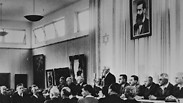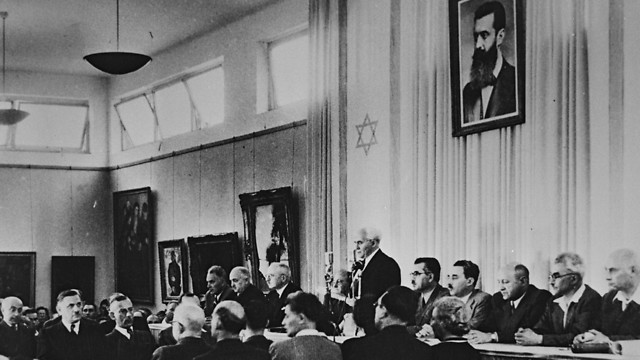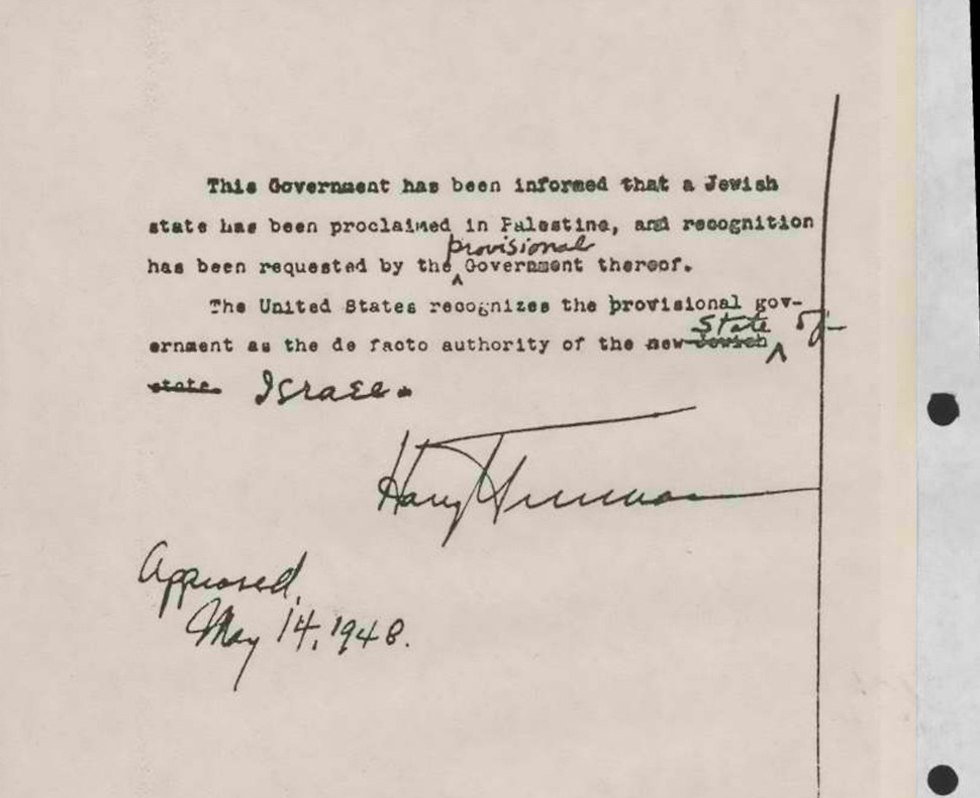
State Archives release historical documents shedding light on Israel's early days
President Truman's letter recognizing Israel is among 150 documents released by State Archives detailing the creation of the IDF, functioning of provisional government, election of first president and deliberation over state symbols.
Some 150 seminal documents were released this week by the State Archives in honor of Israel's 70th anniversary. The rare glimpse they afford at the early days of the state allows one to experience a sliver of the pervasive spirit among the fledging Jewish settlement (Yishuv) that had just gained independence.
One of the documents contains a statement from then-US president Harry Truman, who declared American recognition for the State of Israel on May, 14, 1948: "This Government has been informed that a Jewish state has been proclaimed in Palestine and recognition has been requested by the government thereof. The United States recognizes the provisional government as the de facto authority of the State of Israel."
The message, written just 24 hours before the official declaration of independence 70 years ago, came into effect at midnight and the United States was among the first to recognize the Jewish state in its first month.
The documents touch on many subjects, from how the IDF was established to the division of roles in the transitional government and the attempt by the Israeli forces to break the siege of Jerusalem during the War of Independence.
They not only reveal significant, fateful decision making processes, however, but also bring to light some interesting anecdotes. For example, a letter sent by the Jewish National Council Director Zvi Lurie to the director of radio broadcasting 24 hours before the declaration of independence, with a schedule for the first day of the state.
"At first, I was certain that Ben-Gurion would address the festive meeting apart from reading the declaration as you told me," Lurie wrote. "Since he did not do so, it is right not to settle for the festive meeting, but to invite Ben-Gurion or Shertok (Moshe Sharett—ed) to a brief speech tonight."
Further in the letter, Lurie suggests that the speech be given at the beginning of the broadcast, at around 8:10pm, and concludes with a request that if this does not happen, that Sharett should speak in his place the next day: "If you decide not to, I ask Moshe to speak tomorrow, at least for 10 minutes."
On May 16, 1948, the transitional government met for its first practical meeting and made several critical decisions, as summarized in a synopsis of the meeting. Among other things, it was decided to ask Arab countries to recognize the Jewish state and to appoint representative offices in friendly countries. The assembly also chose Dr. Haim Weizmann as the first president, in a 9-2 vote.
A few days later, Weizmann accepted the position with a reply letter: "I am thrilled by the choice and I accept it. I am sorry that I am not with you right now, but my thoughts and prayers are with the people fighting for our independence in the war. It would be appropriate for Israel to have a future on behalf of those who fell in battle."
Weizmann was referring to the War of Independence, which de fact broke out after the United Nations vote on November 29, 1947, and intensified with the invasion of the Arab armies the day after the declaration of the establishment of the state.
On the May 26, 11 days after the declaration, Ben Gurion announced the formation of the IDF. The IDF order stated that the army would have naval, land and air forces, and that conscription would be instituted in times of war. The government was to decide, at a later date, the draft age.
Eleven days later, government secretary Ze'ev Sherf wrote to all its members that according to the government's decision, the area in which all the government departments would be located in Tel Aviv would henceforth be called the Kirya.
Also among the documents is a letter from President of the Jewish National Council Yitzhak Ben-Zvi to newly elected president Haim Weizmann—dated June 3, 1948—in which the former demands the ‘Hebraization’ of the surnames of new immigrants to make them more Israeli.
"The Hebrew form of life must be ensured, primarily by the assimilation of Hebrew names in public life. The order of the day is to infuse into our lives Hebrew rather than the cloak of the Diaspora,” Ben-Zvi iterated.

The state flag as we know it was officially chosen only on October 28, 1948, almost six months after the declaration of independence. The debate over what the flag would look like lasted from the time of the declaration and dealt with three alternatives.
At a meeting of parliament's Symbols Committee held on June 2, provisionary government member David Remez suggested "a simple flag with two stripes of blue and white," but this idea was rejected by cabinet secretary Shlomo Kedar, who claimed that "such a flag, merely blue and white, already exists in the state of Bavaria and the flag of the city of Lucerne in Switzerland."
The session then dealt with choosing a state emblem and Remez said: “A state emblem is a more urgent matter as the foreign affairs minister mentioned the need to issue visas and place signs above diplomatic buildings in foreign countries.”
He later suggested that the symbol be a shield surrounded by gold, the upper part painted white and the bottom painted blue, an emblem that seems light years away from the Menorah and olive leaves that were finally chosen in February, 1949.













